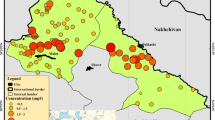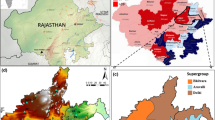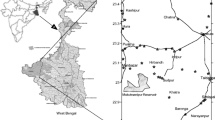Abstract
India is among the 23 nations around the globe where health problems occur due to excess ingestion of fluoride (>1.5 mg/l) by drinking water. In Rajasthan, 18 out of 32 districts are fluorotic and 11 million of the populations are at risk. An exploratory qualitative survey was conducted to describe perception of the community regarding fluoride and related health problems in Central Rajasthan. A study on distribution and health hazards by fluoride contaminate in groundwater was performed in 1,030 villages of Bhilwara district of Central Rajasthan. One thousand thirty water samples were collected and analyzed for fluoride concentration. Fluoride concentration in these villages varies from 0.2 to 13.0 mg/l. Seven hundred fifty-six (73.4%) villages have fluoride concentration above 1.0 mg/l. Sixty (5.83%) villages have fluoride concentration above 5.0 mg/l with maximum numbers (24, 19.5%) from Shahpura tehsil. A detailed fluorosis study was carried out in 41 villages out of 60 villages having fluoride above 5.0 mg/l in the study age, sex, and occupation data were also collected. Four thousand, two hundred fifty-two individuals above 5 years age were examined for the evidence of dental fluorosis, while 1998 individuals above 21 years were examined for the evidence of skeletal fluorosis. The overall prevalence of dental and skeletal fluorosis was found to be 3,270/4,252 (76.9%) and 949/1,998 (47.5%), respectively. Maximum of 23.9% (1,016) individuals have mild grade of Dean’s classification. Three hundred seventy-four (8.8%) individuals have severe type of dental fluorosis. The Dean’s Community Fluorosis Index for the studied area in total is 1.62. Maximum CFI 3.0 was recorded from Surajpura of Banera Tehsil. Five hundred sixty-six (28.3%) individuals have Grade I type of skeletal fluorosis while only 0.6% (12) individuals have Grade III skeletal fluorosis. In conclusion, the prevalence and severity of fluorosis increased with increasing fluoride concentration. It was interesting to note that in some villages, the prevalence and severity of fluorosis were highest in subjects belonging to the economically poor community. Similarly, male laborers showed highest prevalence of fluorosis. Prevalence and severity of fluorosis were observed higher in subjects using tobacco, bettle nuts, and alcoholic drinks. In contrast, subjects using citrus fruits and having good nutritional status showed low prevalence.
Similar content being viewed by others
References
APHA (1991). Standard methods for the examination of water and wastewater (17th ed.). Washington, DC: American Public Health Association.
Ayoob, S., & Gupta, A. K. (2006). Fluoride in drinking water: A review on the status and stress effects. Critical Reviews in Environmental Science and Technology, 36, 433–487. doi:10.1080/10643380600678112.
Azar, H. A., Nucho, C. K., Bayyuk, S. I., & Bayyuk, W. B. (1961). Skeletal fluorosis due to chronic fluoride intoxication. Cases from an endemic area of fluorosis in the region of the Persian Gulf. Annals of Internal Medicine, 55(2), 193–200.
Bilbeissi, M. W., Fraysee, C., Mitre, D., Kerebel, M., & Kerebel, B. (1988). Dental fluorosis in relation to tea drinking in Jordan. Fluoride, 21(3), 121–126.
Brouwer, I. D., De Bruin, A., Dirks, O. A., & Hautvast, J. (1988). Unsuitability of WHO guidelines for fluoride concentration in drinking water in Senegal. Lancet, I, 223–225. doi:10.1016/S0140-6736(88)91073-2.
Brown, E., Skougstad, M. W., & Fishman, M. J. (1974). Method for collection and analysis of water sample for dissolved minerals for dissolved minerals and gases (Book No. 5). Washington, DC: US Department of Interior.
Bureau of Indian Standard (BIS) (1991). Indian standard specification for drinking water (pp. 2–4). Delhi: BIS, IS 10500.
Census (2001). District Bhilwara, Rajasthan, Government of Rajasthan.
Choubisa, S. L., & Sompura, K. (1996). Dental fluorosis in tribal villages of Dungarpur district (Rajasthan). Pollution Research, 15(1), 45–47.
Cuifeng, L., Wyborny, L. E., & Chan, J. T. (1995). Fluoride content of dairy milk from supermarket. A possible contributing factor to dental fluorosis. Fluoride, 28(1), 10–16.
Dean, H. T. (1942). The investigation of physiological effects by the epidemiological method. American Association for the Advancement of Science, 19, 23–31.
Desai, V. R., Saxena, D. K., Bhavasar, B. S., & Kantharia, S. L. (1988). Epidemiological study of dental fluorosis in tribal residing near fluorspar mines. Fluoride, 21(2), 137–141.
Godfrey, S., Wate, S., Kumar, P., Swami, A., Rayalu, S., & Rooney, R. (2006). Health-based risk targets for fluorosis in tribal children of rural Madhya Pradesh. In India 32nd WEDC international conference. Colombo, Sri Lanka, 2006.
Guanglu, B. (2007). Screening high-fluoride and high-arsenic drinking waters and surveying endemic fluorosis and arsenism in Shaanxi province in western China. Water Research, 41(5), 1168. doi:10.1016/j.watres.2006.11.002.
Han, Y. Z., Zhang, J. Q., Lie, Z. Y., Zhang, L. Z., Yu, X. H., & Dai, J. A. (1995). High fluoride content of food and endemic fluorosis. Fluoride, 28(4), 201–202.
Hussain, J. (2001). Studies on the impact of industrial and domestic waste on groundwater quality. Ph.D. Thesis, MDS University Ajmer Rajasthan, India.
Hussain, I., Hussain, J., Sharma, K. C., & Ojha, K. G. (2002). Fluoride in drinking water and health hazardous: Some observations on fluoride distribution Rajasthan. In Environmental Scenario of 21st Century (pp. 355–374). New Delhi: APH.
Hussain, J., Shrama, K. C., Arif, M., & Hussain, I. (2007). Fluoride distribution and modeling using best subset procedure in Nagour District of Central Rajasthan, India. In The XXVIITH conference of the international society for fluoride research (ISFR XXVII), 9–12 October, 2007. Beijing, China.
Hussain, J., Sharma, K. C., & Hussain, I. (2003). Fluoride distribution in groundwater of Raipur Tehsil in Bhilwara District. International Journal of Bioscience Reports, 1(3), 580–587.
Hussain, J., Sharma, K. C., & Hussain, I. (2004a). Fluoride in drinking water and its ill affect on Human Health: A review. Journal of Tissue Research, 4(2), 263–273.
Hussain, J., Sharma, K. C., & Hussain, I. (2004b). Fluoride in drinking water and health hazards: Some observations of fluoride distribution in Sahara Tehsil of Bhilwara District, Rajasthan. Bioscience and Biotechnology Research Asia, 2(2), 107–116.
Hussain, J., Sharma, K. C., & Hussain, I. (2005a). Fluoride distribution in groundwater of Banera Tehsil in Bhilwara District, Rajasthan. Asian Journal of Chemistry, 17(1), 457–461.
Hussain, J., Sharma, K. C., & Hussain, I. (2005b). Fluoride contamination in groundwater sources of Hurda Tehsil of Bhilwara, Rajasthan. Pollution Research, 24(2), 431–434.
Hussain, J., Sharma, K. C., Ojha, K. G., & Hussain, I. (2000). Fluoride distribution in ground waters of Sirohi district in Rajasthan. Indian Journal of Environment and Eco-planning, 3(3), 661–664.
Jacks, G., Rajagopalan, K., Alveteg, T., & Jonsson, M. (1993). Genesis of high-F groundwaters, southern India. Applied Geochemistry, 2, 241–244.
Jolly, S. S., Prasad, S., & Sharma, R. (1970). Endemic fluorosis in India. The Journal of the Association of Physicians of India, 18, 459–471.
Khaiwal, R., & Garg, V. K. (2007). Hydro-chemical survey of groundwater of Hisar City and assessment of defluoridation methods used in India. Environmental Monitoring and Assessment, 132(1–3), 33–43. doi:10.1007/s10661-006-9500-6.
Li, Y., Liang, C. K., Katz, B. P., Niu, S., Cao, S., & Stookey, G. K. (1996). Effect of fluoride exposure and nutrition on skeletal fluorosis. Journal of Dental Research, 75, 2699.
Opinya, G. N., Bwibo, N., Valderhaug, J., Birkeland, J. M., & Lokken, P. (1991). Intake of fluoride through food and beverages by children in high fluoride (9 ppm) area in Kenya. Discovery and Innovation, 3(4), 71–76.
Raina, A. K., & Kant, S. (1995). Dental fluorosis. A case study in three villages of district Rajauri (J&K). Proceedings of the Academy of Environmental Biology, 4(2), 143–146.
Sharma, K. C., Arif, M., Hussain, I., & Hussain, J. (2007). Observation on fluoride contamination in groundwater of district Bhilwara, Rajasthan and a proposal for a low cost defluoridation technique. In The XXVIITH conference of the international society for fluoride research (ISFR XXVII), 9–12 October, 2007. Beijing, China.
Singh, A., Jolly, S. S., Bansal, B. C., & Mathur, O. C. (1963). Endemic fluorosis. Medicine, 42, 229–246. doi:10.1097/00005792-196305000-00003.
Susheela, A. K. (1993). Prevention and control of fluorosis in India. Health Aspect (Vol. I). New Delhi: Rajeev Gandhi National Drinking Water Mission, Ministry of Rural Development.
Teotia, S. P. S., Teotia, M., & Singh, D. P. (1985). Bone static and dynamic histomorphometry in endemic fluorosis. Fluoride research. Studies in environmental sciences, (Vol. 27, pp. 347–355). Amsterdam: Elsevier.
UNICEF (1999). States of the art report on the extent of fluoride in drinking water and the resulting endemicity in India. Report by fluorosis and rural development foundation for UNICEF. New Delhi: UNICEF.
USPHS (United States Public Health Service) (1962). Drinking water standards. USPHS, Publications 956. Washington DC: USGPO.
Whitford, G. M. (1997). Determinants and mechanisms of enamel fluorosis. Ciba Foundation Symposium, 205, 226–241.
Whitford, G. M., Pashley, D. H., & Stringer, G. I. (1976). Fluoride renal clearance: A 334 pH-dependent event. The American Journal of Physiology, 230, 527–532.
WHO (World Health Organization) (1984). Fluorine and fluoride (Vol. 36). Geneva: Environmental Health Criteria.
WHO (World Health Organization) (1996). Guideline for drinking water quality. Geneva: World Health Organization.
WHO (World Health Organization) (2006). Fluoride in drinking water (p. 144). London, UK: IWA Publishing.
Zheng, B. S., Dingm, Z. H., Huang, R. G., Zhu, J. M., Yu, X. Y., Wang, A. M., et al. (1999). Issues of health and disease relating to coal use in southwestern China. International Journal of Coal Geology, 40(2–3), 119–132. doi:10.1016/S0166-5162(98)00064-0.
Author information
Authors and Affiliations
Corresponding author
Rights and permissions
About this article
Cite this article
Hussain, J., Hussain, I. & Sharma, K.C. Fluoride and health hazards: community perception in a fluorotic area of central Rajasthan (India): an arid environment. Environ Monit Assess 162, 1–14 (2010). https://doi.org/10.1007/s10661-009-0771-6
Received:
Accepted:
Published:
Issue Date:
DOI: https://doi.org/10.1007/s10661-009-0771-6




